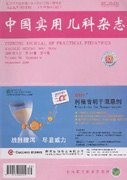|
Comparison of the diagnostic values of two criteria for the diagnosis of hypertrophic cardiomyopathy in children
SHAN Guang-song*,WANG Ben-zhen,GUO En-yu,et al
2020, 35(3):
217-221.
DOI: 10.19538/j.ek2020030613
Objective To compare the diagnostic results and values of two criteria for hypertrophic cardiomyopathy(HCM) in children:Expert Consensus on the Diagnosis of Children Hypertrophic Cardiomyopathy in China(Served as domestic criteria) and 2014 ESC Guidelines on Diagnosis and Management of Hypertrophic Cardiomyopathy(Served as ESC guidelines). Methods The clinical data of 67 patients with HCM who were treated in Qingdao Women and Children’s Hospital from June 2015 to June 2019 were retrospectively analyzed. The diagnosis was made respectively according to the domestic criteria and ESC guidelines,and the results were set as confirmed or excluded. The ECG and genetic testing results were used as the gold standard to compare the sensitivity,specificity and accuracy of the two criteria for the diagnosis of HCM. Results For the entire group of cases,20 cases were older than 1 year old,and 47 cases were younger than 1 year old. Genetic testing was performed in 22 children(32.8%),and genetic variation was confirmed in 20 children. Based on the echocardiography and genetic testing,36 cases were diagnosed as HCM and others were excluded. According to ESC guidelines,48 cases were diagnosed,but 12 cases were misdiagnosed. Based on domestic criteria,34 cases were diagnosed,and 2 cases were missed,no misdiagnosis. The sensitivity and specificity were 94.4% and 93.5% respectively for domestic criteria,and for ESC guidelines,they were 100.0% and 61.3%;the accuracy was 97.0% for domestic criteria and 82.1% for ESC guidelines. The Youden index had significant difference between domestic criteria and ESC guidelines(U=2.92,P<0.01). For the cases younger than 1 year old,the sensitivity and specificity were 100.0% and 53.8% for ESC criteria,while for domestic guidelines,they were 90.5% and 100.0%,and the accuracy was 76.6% for ESC criteria and 95.7% for domestic guidelines. The Youden index had significant difference between ESC criteria(0.538) and domestic guideline(0.828)(U=2.87,P<0.01). For the cases older than 1 year old,the sensitivity,specificity and accuracy in the two groups were all 100%. Conclusion The domestic criteria is better than the ESC guidelines,which significantly improves the specificity and accuracy of diagnosis in HCM children. Therefore,the domestic criteria is more suitable for the diagnosis of HCM children in China.
|

